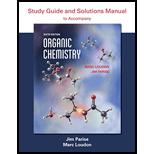
Concept explainers
(a)
Interpretation:
The given compounds couldin principle be resolved into enantiomers at very low temperatures or not is to be identified.
Concept introduction:
A carbon atom that has four nonequivalent atoms or groups attached to it is known as the chiral carbon atom. Chiral carbon centers are also called as asymmetric or stereogenic centers. A carbon atom that does not have four nonequivalent atoms or groups attached to it is known as an achiral carbon atom.
(b)
Interpretation:
The given compounds couldin principle be resolved into enantiomers at very low temperatures or not is to be identified.
Concept introduction:
A carbon atom that has four nonequivalent atoms or groups attached to it is known as the chiral carbon atom. Chiral carbon centers are also called as asymmetric or stereogenic centers. A carbon atom that does not have four nonequivalent atoms or groups attached to it is known as an achiral carbon atom.
(c)
Interpretation:
The given compounds couldin principle be resolved into enantiomers at very low temperatures or not is to be identified.
Concept introduction:
A carbon atom that has four nonequivalent atoms or groups attached to it is known as the chiral carbon atom. Chiral carbon centers are also called as asymmetric or stereogenic centers. A carbon atom that does not have four nonequivalent atoms or groups attached to it is known as an achiral carbon atom.
Want to see the full answer?
Check out a sample textbook solution
Chapter 6 Solutions
Organic Chemistry Study Guide and Solutions
- Which is the enantiomer of this molecule? NH2 (A) (C) B NH2 デ NH2 H- さ NH, (B) (D) H2N- Harrow_forwardWhich of the following compounds is optically active? Explain your answer. (C4) Cl,C=CH(CH,) NH,CHCOOH (CH,),C(NH, )COOH CH(CH,), A вarrow_forwardDraw a Fischer projection for each of the following molecules shown in its zigzag conformation. (a) OH (b) OH (c) OH CI HO HO HO `CN HƠ CGH5 OH OH OH OHarrow_forward
- What is the relationship between these structures? H3CH2C OH CH3 HỌC HỒ CH(CH3)2 (A) conformers (C) enantiomers HO CH(CH3)2 CH2CH3 H3C OH CH3 (B) diastereomers (D) identicalarrow_forwardNonearrow_forwardWhich of the following compounds are chiral? Draw them, and label the chirality centers. (a) 2, 4-Dimethylheptane (b) 5-Ethyl-3, 3-dimethylheptane (c) cis-1, 4-Dichlorocyclohexanearrow_forward
- Determine the weakest C-C bond in each of the compounds in Problem 25.32.arrow_forwardWhen treated with CrO3, 2-tert-butylcylclohexanol undergoes oxidation reaction to yield 2-tert-butylcyclohexanone. Draw the chair conformation for both isomers. If the axial-OH is generally more reactive than its equatorial isomer, determine the isomer that reacts faster. Explain your answer in (ii)arrow_forwardFollowing is a planar hexagon representation of L-fucose, a sugar component of the determinants of the A, B, O blood group typing. For more on this system of blood typing, see Chemical Connections: A, B, AB, and O Blood Group Substances in Chapter 25. (a) Draw the alternative chair conformations of L-fucose. (b) Which of them is more stable? Explain.arrow_forward
- Q1:- Which of the isomeric alcohols having formula CSH120 are chiral ? Which are achiral? Draw the enantiomers. Q2:- Which of the following compounds are chiral? Draw the stereo structures. a- 1-Chloro-2-bromobutane b- 1,2-Dichloro-3-methyibutanearrow_forwardStereoisomers share the same connectivity and differ only in the way their atoms are arranged in space. Draw the structure of a compound that is a stereoisomer ofarrow_forward4. (a) Draw all possible isomers of C4H3CI2. (b) Indicate which pairs of compounds are enantiomers of one another. (c) Indicate which pairs of compounds are diastereomers of one another. (d) Indicate which compounds would have optical rotations of 0°. (e) Assign R and S configurations to all chirality centers of the compounds in part (a).arrow_forward
 Organic ChemistryChemistryISBN:9781305580350Author:William H. Brown, Brent L. Iverson, Eric Anslyn, Christopher S. FootePublisher:Cengage Learning
Organic ChemistryChemistryISBN:9781305580350Author:William H. Brown, Brent L. Iverson, Eric Anslyn, Christopher S. FootePublisher:Cengage Learning
